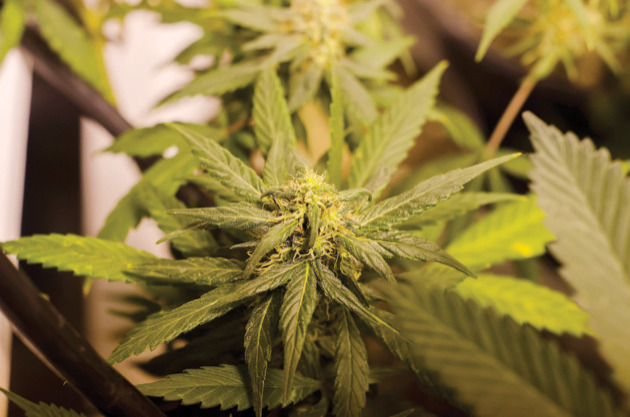While touting data in a federal report showing that marijuana use among Colorado teens is falling, attorney Brian Vicente, who co-authored Amendment 64, the measure that legalized limited recreational cannabis sales in the state, predicted that weed haters would try to twist the numbers to their advantage, and he was right. Days later, Colorado’s most prominent anti-pot organization is acknowledging the stats regarding teen use but raising the alarm about the level of consumption among young adults.
In a statement on view below in its entirety, Henny Lasley, executive director of Smart Colorado, writes that the group “is encouraged by a decrease in past year marijuana use for Colorado kids ages 12-17. But that optimism is offset by an increase among those ages 18-25, with nearly half reporting past year use, the third highest rate in the nation.”
The National Survey on Drug Use and Health, the report to which both Vicente and Lasley refer, was just released under the auspices of the Substance Abuse and Mental Health Services Administration, a federal agency. As we’ve reported, the analysis showed that past-month cannabis use by Coloradans ages twelve to seventeen dropped nearly 20 percent from 2014-2015 to 2015-2016, the most recent period for which statistics are available. The fall from 11.13 percent to 9.08 percent brings the past-month use numbers below those from 2011-2012 (10.47 percent) and 2012-2013 (11.16 percent).
However, past-month marijuana consumption among the 18-25 demographic has indeed increased, albeit by a much smaller amount than for teen use. The 1.4 percent difference between the 31.75 percent total in 2014-2015 to 32.20 percent in 2015-2016 is on the borderline of statistical insignificance, but Smart Colorado is using it to counter Vicente’s argument that Colorado’s regulation of marijuana is helping to prevent teen access.
“Research shows marijuana damages developing brains, which are still growing until age 25,” Lasley maintains, adding, “Amendment 64 legalized recreational marijuana in Colorado only for those 21 or older.”
The survey doesn’t break down numbers in the 18-25 demo in ways that show us how they relate to those under 21, who are consuming illegally, versus folks 21 and over, who have every right to use cannabis under Colorado law. But that’s less noteworthy than Smart Colorado’s shift of focus to young-adult marijuana use now that teen consumption in the state is falling, since it represents a new line of attack from marijuana critics.
Back in August, for example, Kevin Sabet, president and CEO of Virginia-based Smart Approaches to Marijuana, the nation’s leading group against marijuana legalization (and a direct influence on Smart Colorado, right down to its name), cited studies showing that the brains of 25-30-year-olds are still developing — and can still be harmed by weed.
None of this surprises Vicente, who said the following during an interview for our previous post: “Opponents of marijuana legalization dating back for the last eighty years have been prone to picking and choosing statistics to make their case.”
When asked about Smart Colorado’s new spin, Mason Tvert, another Amendment 64 proponent who currently works with Vicente as communications director for VS Strategies, offered a statement of his own. It reads: “It’s nice to see opponents of Amendment 64 are finally acknowledging that teen marijuana use has not increased since legalization in Colorado. It’s also great that they recognize the value of marijuana tax revenue, which is being used to fund important health and education programs throughout the state. Preventing teen cannabis use can be achieved through sensible regulation and public education. It does not require prohibiting use by adults and punishing thousands of responsible adult consumers every year.”
Here’s the aforementioned Smart Colorado release:
Henny Lasley, executive director of Smart Colorado, today provided the following comments on the 2015-2016 National Survey on Drug Use and Health, which was just released by the U.S. Substance Abuse and Mental Health Services Administration:
“Smart Colorado is encouraged by a decrease in past year marijuana use for Colorado kids ages 12-17. But that optimism is offset by an increase among those ages 18-25, with nearly half reporting past year use, the third highest rate in the nation.
“Research shows marijuana damages developing brains, which are still growing until age 25. Amendment 64 legalized recreational marijuana in Colorado only for those 21 or older.
“The reported decrease for those ages 12-17 may reflect efforts supported by Smart Colorado and others to ensure youth prevention and education receive adequate attention and resources.
“This year Smart Colorado supported a move by the Colorado Legislature to fund an additional 150 school behavioral health professionals to better support Colorado kids, families, and schools in addressing the growing challenges of substance use.
“This is certainly not the time to let our guard down as the youth marijuana use rate in Colorado remains among the highest in the nation, and regular use by 18-25 year olds is stunningly high.
“This is particularly of concern as today’s marijuana becomes increasingly potent, with THC rates far exceeding anything experienced in past decades.
“It should also be noted that the new federal survey results are for the entire state of Colorado. With the majority of Colorado jurisdictions opting out of marijuana commercialization, youth exposure and access has been thoughtfully limited.
“But the latest Healthy Kids Colorado Survey showed significantly higher teen marijuana use in Denver and Pueblo, two centers of commercialization, compared to the state as a whole.
“Smart Colorado calls on the General Assembly to continue to direct much-needed revenue towards education, prevention and promoting positive and healthy youth behaviors, while ensuring that state education efforts focus on the realities of today’s new high-THC products and intake methods. Full public disclosure of potential risks and harms at point of sale also remains critically important.”
credit:westword.com













